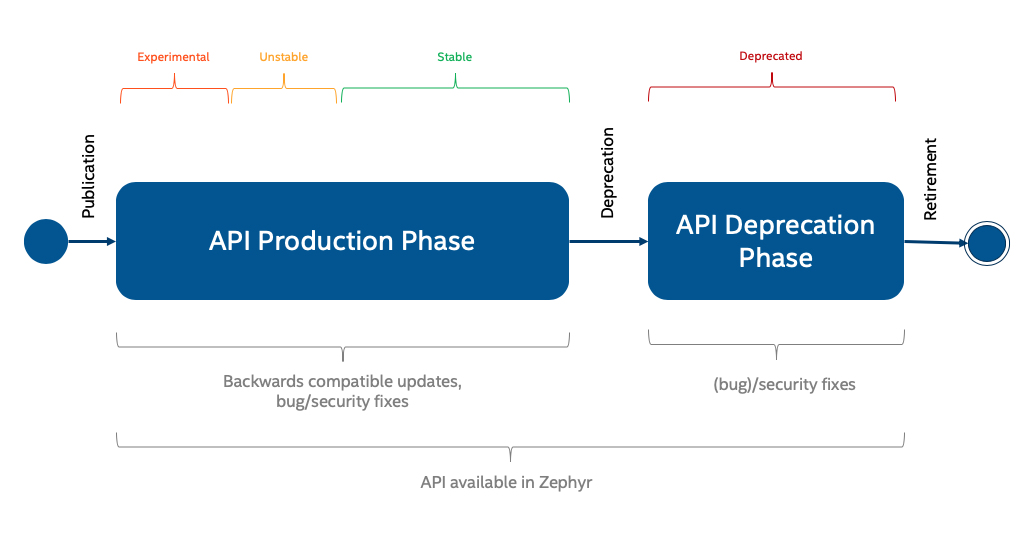API Lifecycle¶
Developers using Zephyr’s APIs need to know how long they can trust that a given API will not change in future releases. At the same time, developers maintaining and extending Zephyr’s APIs need to be able to introduce new APIs that aren’t yet fully proven, and to potentially retire old APIs when they’re no longer optimal or supported by the underlying platforms.

API Life Cycle
Experimental¶
Experimental APIs denote that a feature was introduced recently, and may change or be removed in future versions. Try it out and provide feedback to the community via the Developer mailing list.
Hardware Agnostic APIs¶
For hardware agnostic APIs, multiple applications are required to promote an
API from experimental to unstable.
Unstable¶
The API is in the process of settling, but has not yet had sufficient real-world testing to be considered stable. The API is considered generic in nature and can be used on different hardware platforms.
Note
Changes will not be announced.
Stable¶
The API has proven satisfactory, but cleanup in the underlying code may cause minor changes. Backwards-compatibility will be maintained if reasonable.
An API can be declared stable after fulfilling the following requirements:
- Test cases for the new API with 100% coverage
- Complete documentation in code. All public interfaces shall be documented and available in online documentation.
- The API has been in-use and was available in at least 2 development releases
- Stable APIs can get backward compatible updates, bug fixes and security fixes at any time.
Note
Incompatible changes will be announced in the release notes.
Deprecated¶
Note
Unstable APIs can be removed without deprecation at any time.
The following are the requirements for deprecating an existing API:
- Deprecation Time (stable APIs): 2 Releases The API needs to be marked as deprecated in at least two full releases. For example, if an API was first deprecated in release 1.14, it will be ready to be removed in 1.16 at the earliest. There may be special circumstances, determined by the API working group, where an API is deprecated sooner.
- What is required when deprecating:
- Mark as deprecated
- Document the deprecation
- Code using the deprecated API needs to be modified to remove usage of said API
- The change needs to be atomic and bisectable
- Create a GitHub issue to track the removal of the deprecated API, and add it to the roadmap targeting the appropriate release (in the example above, 1.16).
During the deprecation waiting period, the API will be in the deprecated
state. The Zephyr maintainers will track usage of deprecated APIs on
docs.zephyrproject.org and support developers migrating their code. Zephyr
will continue to provide warnings:
- API documentation will inform users that the API is deprecated.
- Attempts to use a deprecated API at build time will log a warning to the console.
Retired¶
In this phase, the API is removed.
The target removal date is 2 releases after deprecation is announced. The Zephyr maintainers will decide when to actually remove the API: this will depend on how many developers have successfully migrated from the deprecated API, and on how urgently the API needs to be removed.
If it’s OK to remove the API, it will be removed. The maintainers will remove the corresponding documentation, and communicate the removal in the usual ways: the release notes, mailing lists, Github issues and pull-requests.
If it’s not OK to remove the API, the maintainers will continue to support migration and update the roadmap with the aim to remove the API in the next release.